Magento 2 Backend Exploration: Pickups
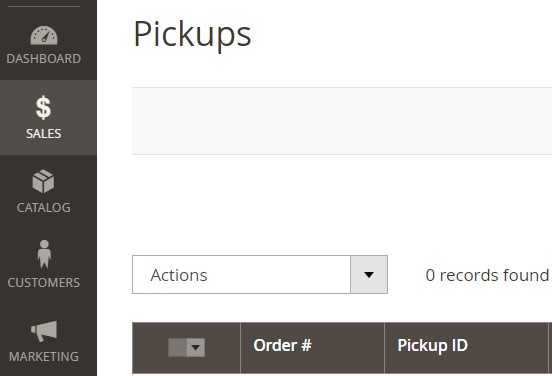
In this article, we continue exploring the Magento 2 admin. This time, we’d like to draw your attention to the Pickups page. The corresponding screen is related to the Click & Collect shipping method. Below, you will discover how to work with the grid. We also shed light on how to import/export pickups in Magento 2 most efficiently.

Table of contents
Magento 2 Pickups Screen
You will discover the Pickups screen under Sales -> Pickups.
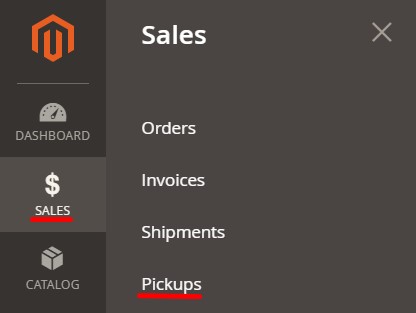
A pickup record is associated with a specific Click & Collect order – just like a shipment. However, there is a difference between the two. In the case of a pickup, you don’t have packaging or quote/booking requirements. Also, note the Click & Collect shipping method is available from the storefront only. As a result, it cannot be used for orders that are created from the Magento 2 admin.
Control elements
You can find numerous control elements commonly used in the Magento 2 admin on the pickups screen.
On the top left, a dropdown with mass actions is situated. You can or print packing slips for multiple grid records simultaneously. To apply mass actions, select pickups you want to manage, tick them, and select an action you want to apply.
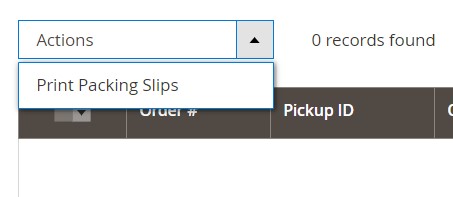
The top right area above the pickups grid contains a search field, filters, grid view switcher, columns configuration, items per page selector, and pagination.
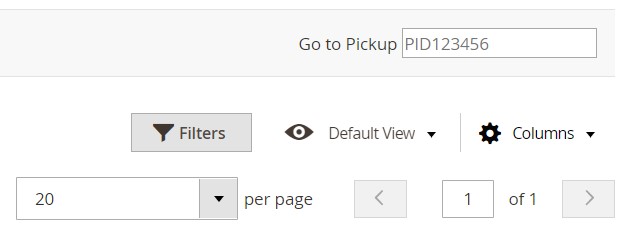
Now, let’s take a separate look at filters. The corresponding tab lets you narrow down the selection of pickups in the grid. You can specify the following parameters:
- Order Date;
- Ready for Pickup Date;
- Origin Location;
- Status.

As for the grid columns, they include the following 8 elements:
- Order #
- Pickup ID
- Order Date
- Customer Name
- Origin Location
- Ready for Pickup Date
- Status
- Action
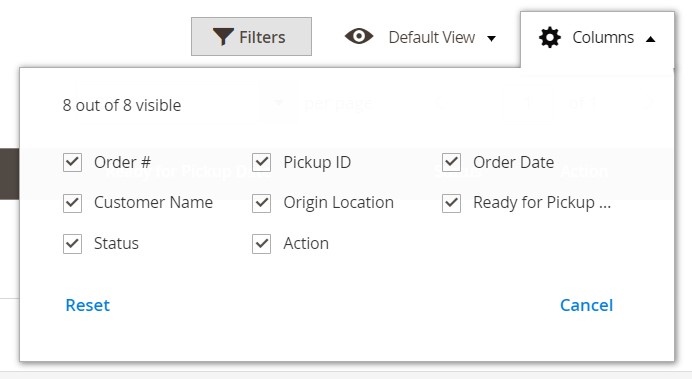
After changing the appearance of the Magento 2 Pickups grid, you can save it as a new view:
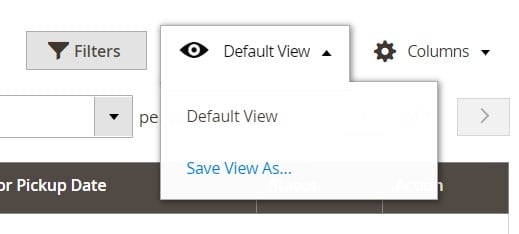
The default Magento 2 Pickups grid
Now, let’s explore how the grid with pickups looks by default. It usually consists of the following 9 columns:
- Checkboxes – select orders for mass actions;
- Order # – a number of a corresponding order;
- Pickup ID – an ID number of a pickup;
- Order Date – date of a corresponding order;
- Customer Name – a name of a customer who created the order;
- Origin Location – a click & collect location;
- Ready for Pickup Date – time when a customer wants to pick up the order;
- Status – current order status;
- Action – you can view each pickup record here.

How to set up pickup at Magento 2 store
- To set up a pickup at your Magento 2 store, you have to access the Pickups page.
- Next, use filters to narrow down the selection of records in the grid. Apply Origin Location to view orders picked up at your designated location or filter the list by a Status field value to display only new pick up records that have to be fulfilled.
- Now, you can print packing slips using mass actions. Download all packing slips as a single PDF file and print them.
- Mark orders as Ready for Pickup to notify customers that their orders are ready for pickup.
- After the customers pick up the items at the designated store, change a pickup status to Picked Up. The corresponding option is available at the upper-right corner of the Pickup record.
How to view a pickup record
Magento 2 offers two ways to view a Pickup record. You can either scan a packing slip barcode or apply a View action from the Action column.
How to cancel a pickup
To cancel a pickup, open it and hit the Cancel Pickup button. That’s it! Items from a pickup with the Ready for Pickup status will be returned to inventory. A customer will receive an email notification about the cancellation.
For further information, follow this link: .
How to import pickups to Magento 2
If you want to import pickups to Magento 2, use the Improved Import & Export extension. The tool will transfer them to your e-commerce website with the corresponding order data.
Unlike the default data transfer solution of Magento 2, the Improved Import & Export module supports numerous file formats and connection points, lets you apply mapping presets, and automates data synchronization with the help of schedules. We will describe its benefits in a separate section below. Now, let’s figure out how to import pickups to Magento 2.
Go to System->Improved Import/Export->Import Jobs and hit the “Add New Job” button.
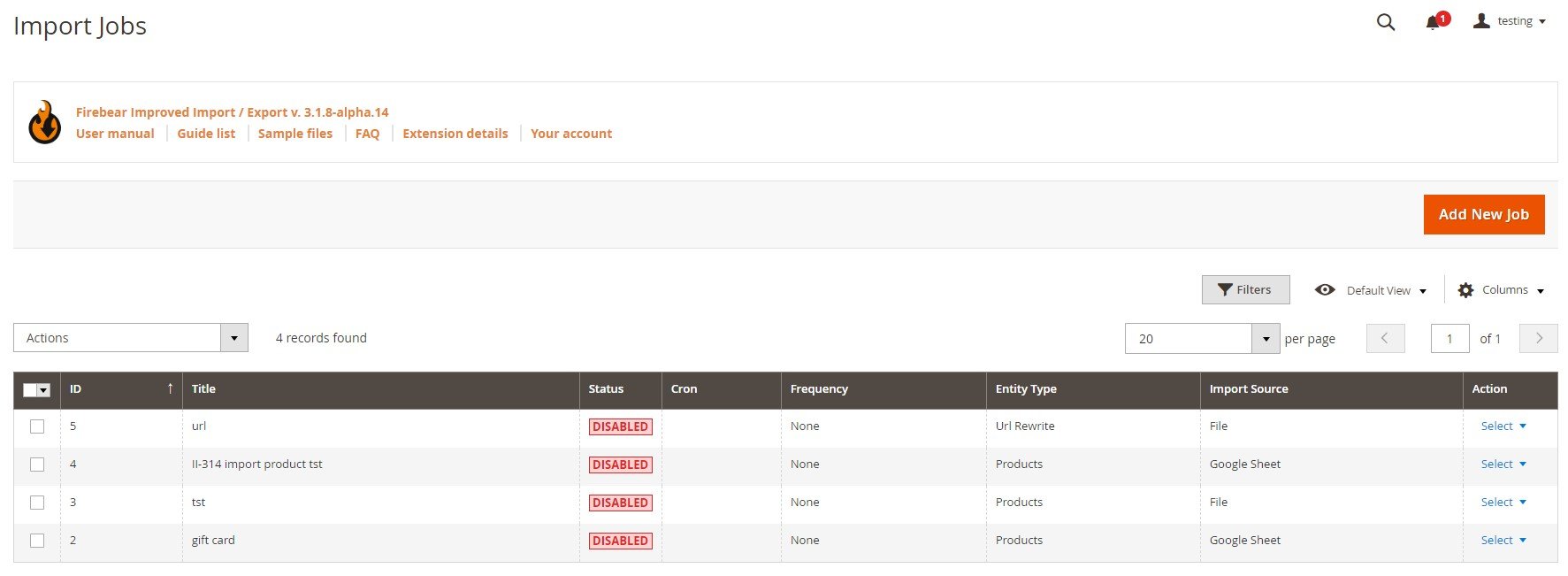
Go to General Settings and enable the job, specify its title, choose the manual run frequency, select a language (locale), and enable/disable the following features depending on your business needs:
- Generate Unique Url if Duplicate;
- Re-Index after Import;
- Send email from new tracks.
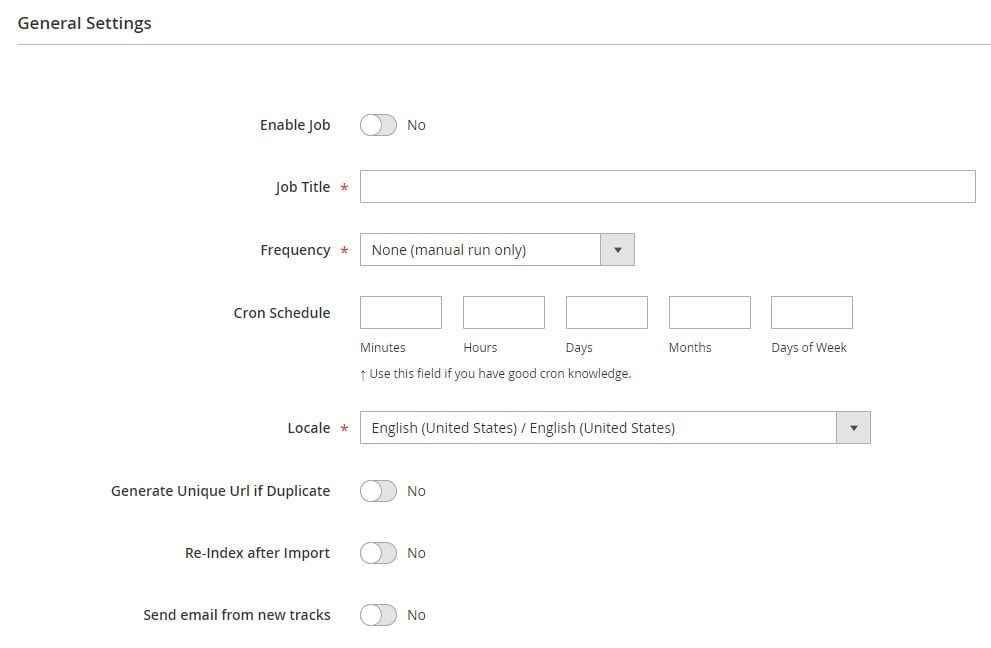
Now, go to Import Settings to enable/disable API depending on your needs, choose Orders in the Entity dropdown (the extension will import pickups to Magento 2 as a part of your orders file), and select a platform to apply a mapping preset.
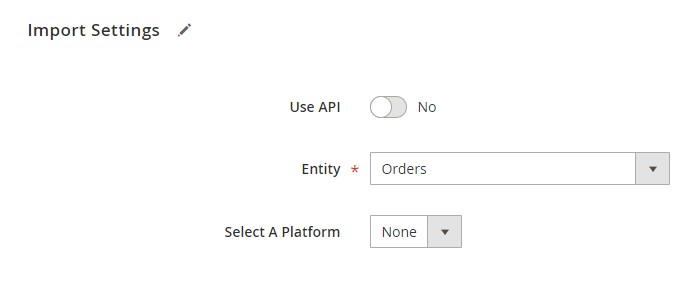
Proceed to the Import Behavior section. Here, you can select Add/Update from the dropdown, choose a validation strategy, specify the maximum possible number of errors, and type separators.

While on the Import Source tab, select an import file type (CSV or another standard) and specify your import source. You can import a data file from a server, Dropbox account, URL, or upload it directly. In the case of Dropbox, specify a file path, access token, and remote images directory.
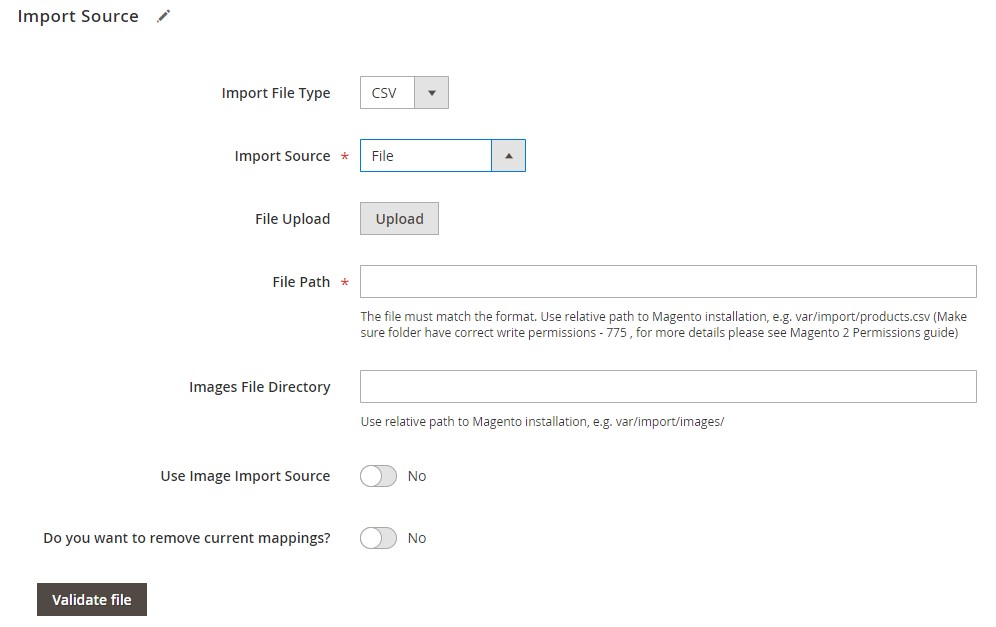
Finally, you can validate the data file with orders to import pickups to Magento 2. If it contains attributes that are not supported by your website, apply mapping.
To start importing pickups to Magento 2, hit “Save & Run” in the top right corner of the screen. For further information about pickup import, follow the link below and contact our support:
Get Improved Import & Export Magento 2 Extension
How to Export pickups From Magento 2
If you want to export pickups from Magento 2, you can streamline the Improved Import & Export Magento 2 extension as well. Automate the default export process and eliminate manual data files modification!
Go to System->Improved Import/Export->Export Jobs and hit the “Add New Job” button.
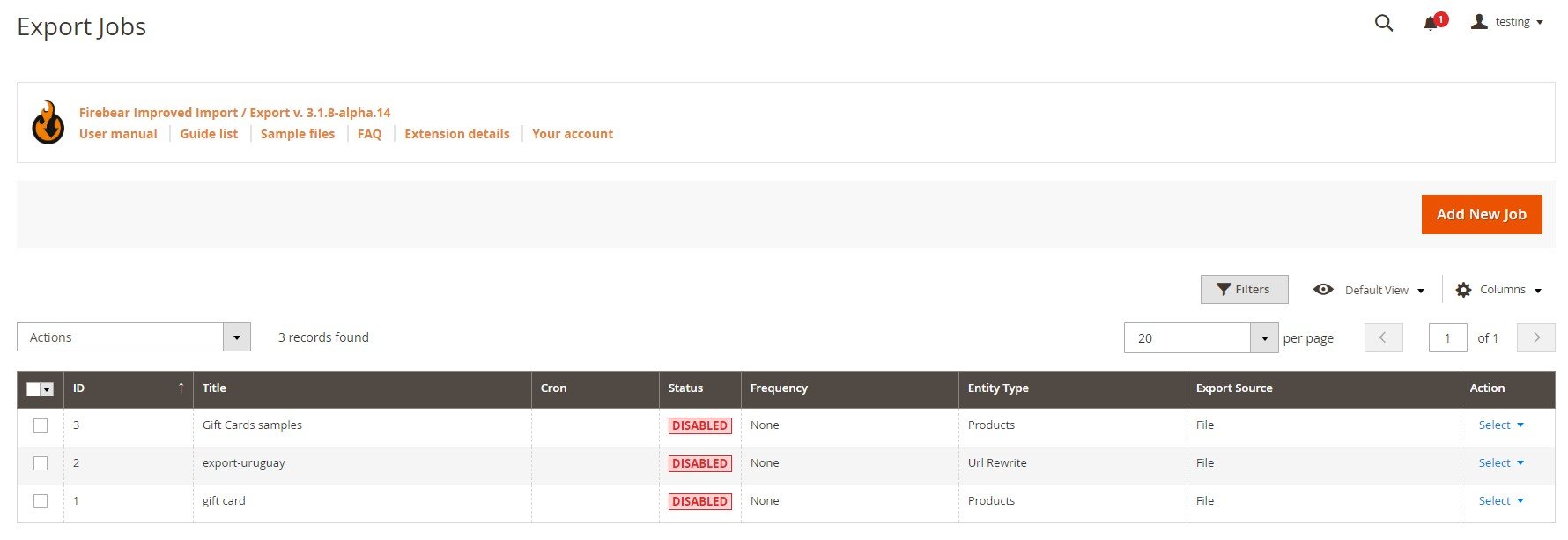
While on the General Settings tab, enable the job, type its title, and select a frequency. Choose a local file language and divide additional attributes if necessary.
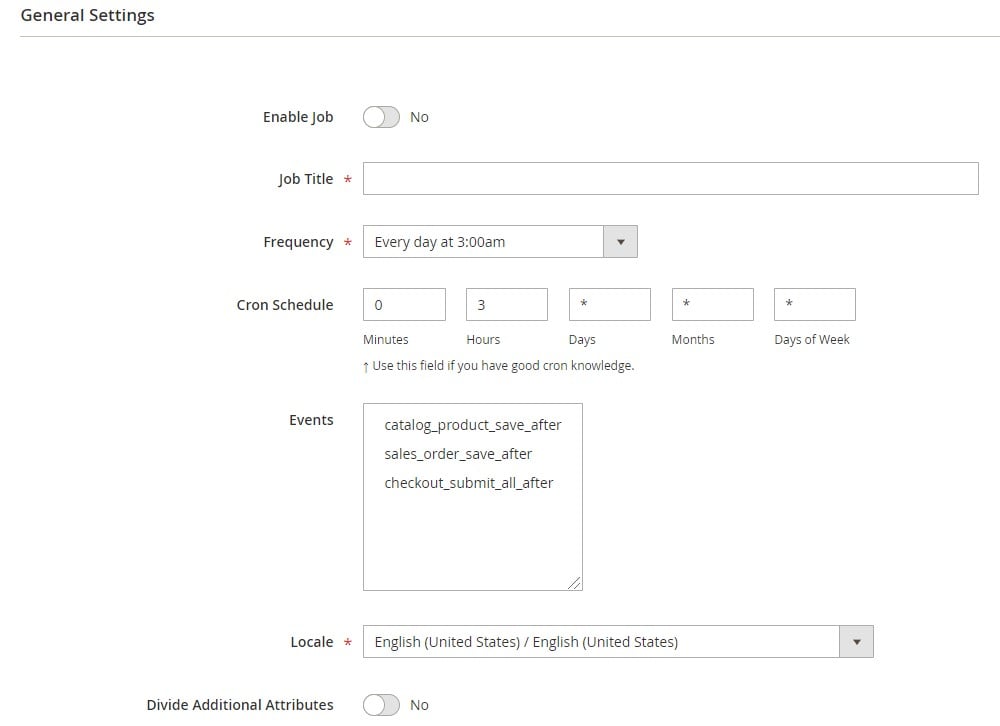
Now, proceed to the Export Settings. Here, you can select Order from the Entity dropdown and enable Consecutive Export.
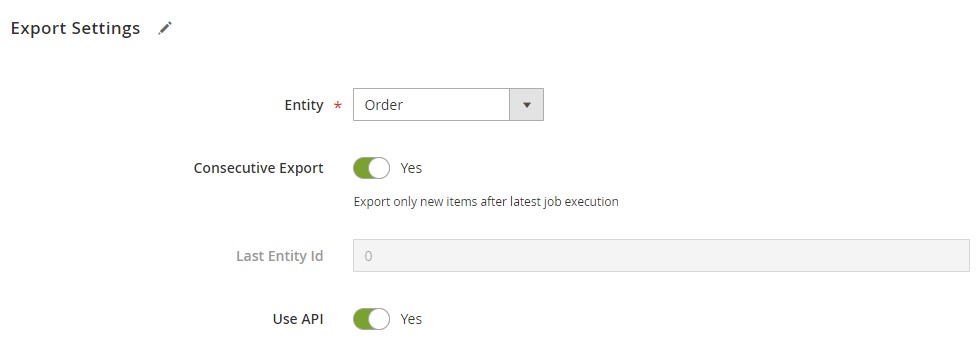
Continue to Export Behavior to select a format of your export file and choose order entities that should be provided to the external platform.
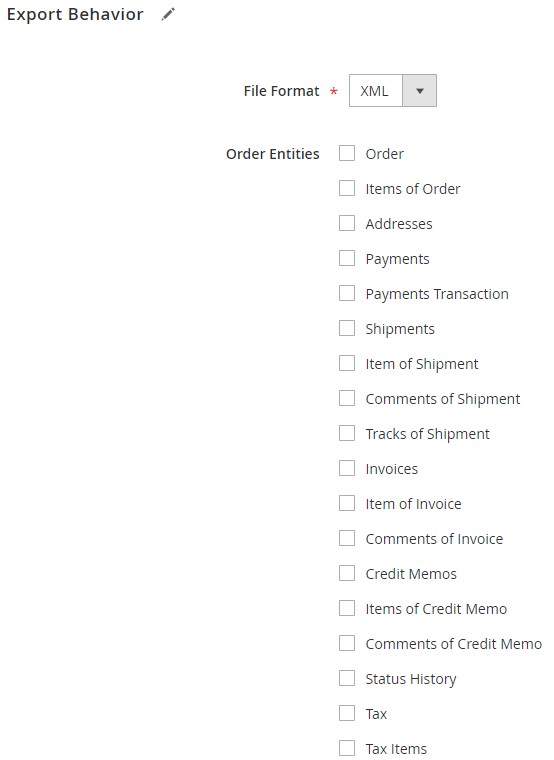
Go to the Export Source tab to configure a destination of your pickups should be transferred to. Choose between FTP, SFTP, or a data file. Check the connection before going any further.

Map attributes and add filters if necessary. Both instruments let you provide the external system with the exact data it requires.
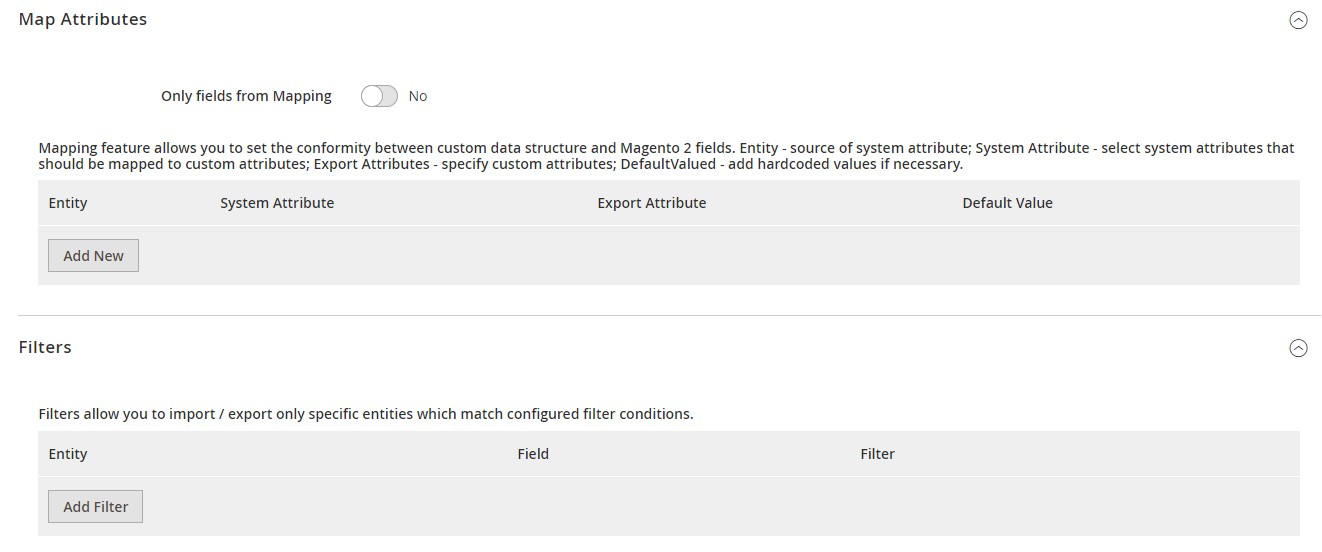
To start the pickups export, hit “Save & Run” in the top right corner of the screen. For further information, follow the link below and contact our support:
Get Improved Import & Export Magento 2 Extension
Improved Import & Export Features

Now, let’s concentrate on the features of the Improved Import & Export extension that simplify the transfer of pickups. With the help of this tool, you will turn your Magento 2 admin into a central hub with all the necessary controls for all integrations. With much higher potential than any import/export solution currently available on the market, Improved Import & Export surpasses market leaders not to mention the default transfer tools of Magento 2 Commerce.
The extension provides several ways of moving order data including pickups to and from your e-commerce website. It even provides a direct connection between the two systems. As an admin, you can manage all integrations right in the backend interface. And as it was mentioned above, the plugin allows automating all order import and export processes in Magento 2 transferring pickups and other data at a specified time.
Automated Import & Export Processes
With the Improved Import & Export Magento 2 extension, you get two different ways of automating shipment data import and export: schedules and event-based triggers. We describe the principle behind both mechanisms below.
Schedules
With the Improved Import & Export Magento 2 extension, you can use the default cron syntax to create export schedules moving Magento 2 pickups to a remote platform. The module provides the ability to specify any custom intervals so that you can create a schedule suitable for your specific business needs. At the same time, you can choose one of the predefined intervals. And don’t forget about the opportunity to create import and export profiles which have no schedules. If you only need to move data once, there is no need to schedule the profile.
Another cool feature related to schedules is the ability to launch every profile manually. For instance, you need to transfer pickups to an external system every day at 6 PM, but no orders have been placed yet. If the first order has been placed after 6 PM, you can easily move it to an eternal system manually transferring all the related pickups.

Events
Event-based triggers represent the second way of automating data transfers in Magento 2. The Improved Import & Export extension enables real-time updates based on them. Create and configure a trigger specifying conditions to synchronize two systems right after certain actions take place. For further information, check this article: How to Run Magento 2 Import or Export After Specific System Event or Process.
Advanced Mapping Features
The following chapter discusses another important aspect of the Improved Import & Export Magento 2 extension – the ability to solve problems caused by different attribute standards. Our module provides several exclusive mapping features that dramatically simplify the way you import and export pickups in Magento 2
Mapping Presets
The Improved Import & Export Magento 2 extension offers a very straightforward way of matching external attributes to ones used internally. You get a series of mapping presets which provide the ability to implement attribute matching in a few clicks. After creating and configuring a new job, choose a suitable preset in the mapping section of your new profile. Next, the Improved Import & Export Magento 2 extension will do all the work for you.
Instead of figuring out what third-party attributes are utilized in your order file, let our module analyze the input data and match all third-party designations to the internal ones. Any manual interactions with data files are eliminated. Here is how everything works:

Matching Interface
If the available presets are not suitable for your integration or you want to make an import/export file suitable for third-party requirements manually, utilize the matching interface of the Improved Import & Export Magento 2 extension. Select an entity, choose a system attribute and specify the corresponding external one in front of it as shown below:
In the grid above, there is also the third column – “Default Value” – where you can specify hardcoded (default) values, which are attribute values automatically provided to every item related to the attribute. It is handy when, for instance, you import products from multiple store views to a single one.
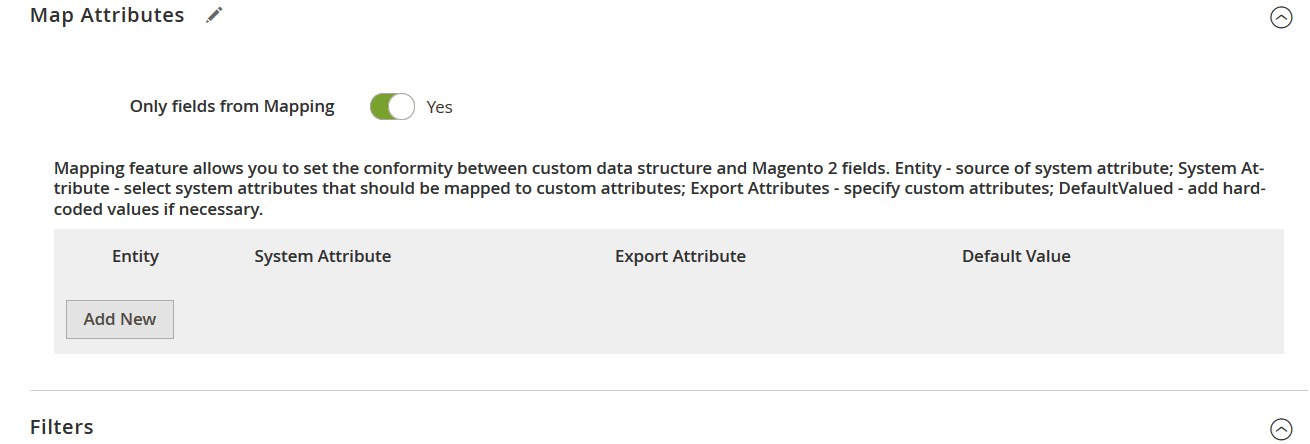
Filters
Now when you know how to apply mapping and use hardcoded (default) values, we’d like to describe another feature that lets you export Magento 2 pickups to a remote system – filters. Follow these steps to master the tool:
- Click the ‘Add Filter’ button;
- Select an entity;
- Select a system attribute that will be used as a basis of a new filter;
- Specify parameters applied for filtering;
- Repeat the previous steps to create more filters.
Note that parameters applied for filtering vary, depending on the chosen attribute. Everything is simple and intuitive:

Attribute Values Mapping
Besides, the Improved Import & Export Magento 2 extension provides the ability to match attribute values. Since incorrect values may prevent import processes or may not be accepted by third-party systems, it is essential to replace all unsupported designations. Unfortunately, the default Magento tools don’t let you do that. But our plugin offers an interface similar to the one we’ve just described above. Choose a third-party designation and specify a corresponding internal one in front of it right in your Magento 2 admin. Repeat matching until no external values are left. For further information, read this article: Attribute Values Mapping.
Attribute Values Editing
The Improved Import & Export Magento 2 module lets you not only map attribute values but also edit them in bulk via the following rules:
- Add a prefix to multiple attribute values;
- Add a suffix to multiple attribute values;
- Split multiple attribute values;
- Merge multiple attribute values.
Note that the module provides the ability to create various conditions to increase the efficiency of editing. For further information, check this article: How to Modify Attribute Values During Import and Export in Magento 2.
Category Mapping
Another feature of the Improved Import & Export Magento 2 extension that simplifies data import is category mapping. It is especially useful when you transfer products from third-party catalogs. The module provides the ability to match external product categories to ones used internally as follows:

And you can create new categories on the fly. Both features are described here: Category Mapping.
Attributes On The Fly
Another feature that dramatically simplifies any import process is the ability to create attributes on the fly. If an update file doesn’t include all the required data, our module allows specifying all parameters necessary to get all missing attributes automatically:
Attribute|attribute_property_name:attribute_property_value|…
The procedure is described in more detail here: Product attributes import.
Extended Connectivity Options
As mentioned above, the Improved Import & Export Magento 2 module allows extending the default opportunities related to data transfers. It offers several new connectivity options that are not available in a standard admin interface.
Multiple File Standards
The Improved Import & Export Magento 2 extension lets you import and export pickups and other data with the help of the default CSV format as well as XML, JSON, ODS, and Excel. There is no need to convert files into CSV and vice versa!
Multiple File Sources
And the vital improvement that enables extended order file import/export with pickups in Magento 2 is support for multiple sources:
- FTP/SFTP. Transfer data files using a local or remote server.
- Dropbox. Use a Dropbox account to establish a connection between the two systems. Alternatively, you can rely on Box, OneDrive, Google Drive, iCloud, and Amazon Drive.
- URL. A direct URL can be used to import a data file as well.
In case an update file is compressed, the Improved Import & Export Magento 2 extension will extract it automatically!

Alternative Ways of Import & Export
The alternative ways of import and export, which are not represented in Magento 2, include data transfers via API and intermediary services.
The Improved Import & Export extension provides the ability to leverage REST, SOAP, and GraphQL APIs to import and export pickups between Magento 2 and any external systems.
As for the intermediary services, they include Google Sheets, Office 365 Excel, and Zoho Sheet. The following image shows how to use Google Sheets to move data to Magento 2:

Another important feature is support for WSDL and WADL.
The video below displays other details of our extension:
Final Words
Now, you can effortlessly manage pickups in the Magento 2 admin. Although things become more complicated when you need to synchronize the data between your e-commerce store and external platforms, the Improved Import & Export Magento 2 extension is always here to help you. The module will enable multiple integrations automating all data transfers. For further information regarding the Magento 2 pickups import and export, follow the link below and contact our support:
Get Improved Import & Export Magento 2 Extension









